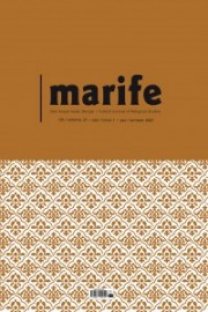Hasan et-Turâbî ve “Et-Tefsîru’t-Tevhîdî” Adlı Eserindeki Metodu -Fâtiha Sûresi Tefsiri Örneği
Hasan et-Turâbî, incelediğimiz Fâtiha sûresinin yorumunda, tefsir kıstasları açısından aklı öne çıkaran, tefsîrde Arapçanın orijinal haliyle referans olarak kullanılmasını öneren, nassın asıl manasını ve ana fikrini merkeze alan bir metot izlemiştir. Ona göre Kur’ân her dönemde hem Müslümanlar hem de gayrimüslimler için yeniden yorumlanmalıdır. Kur’ân nasıl akide, helal-haram, hukuk, şeriat ve ibadet alanlarında özlü açıklamalarla yetiniyorsa, tefsirler de bu hususta onun beyan üslubunu benimsemelidir. Onun için tefsirler; fıkhî, kelâmî ve tarihî ihtilaflara girmemeli ayrıca felsefi yaklaşımlara karşı da mesafeli bir duruşu sembolize eden bir açıklama yolunu seçmelidir. Tefsirinde şahsa ve cemiyete olumlu veya olumsuz yönde şekil verecek her değeri, düşünce ve hareket mantığını önemseyen Turâbî, Fâtiha tefsirinde bu türden konulara genişçe değinmeye çalışmıştır. O, tefsir metodu olarak öncelikle sûrenin konularını özetlediği bir “giriş” (Hulâsatu Hedyi’s-Sûre) ile sûreyi tanıtmaktadır. Ardından ayetlerin izahına geçmektedir. Burada “Tertîlu’l-Âyât” başlığı altında başta işaret ettiği ayetleri birer birer izah etmektedir. Sonunda “Umûmu’l-Âyât” başlığıyla başta işaret ettiği ayetlerin ana fikrini, temel kavramlarını ve en önemli mesajını özetlemektedir. Turâbî böylece okumaya çokça vakti olmayanlara bu özetlerle Kur’ân Mesajını kısaca vermeyi amaçlamaktadır
Anahtar Kelimeler:
Fâtiha, Namaz, Hedyü’s-Sûre, Tertîlu’l-Âyât, Umûmu’l-Âyât.
The Methot which is Followed in the Hasan al-Turabi's Commentary "al-Tafseer alTawhidi" (Commentary Example of al-Fatiha Surah)
Hassan al-Turabi follows a method which puts forward the mind in the criterions of commentary and recommends a return to the original Arabic and takes the main idea and meaning of “Nas” religious texts as the base in his commentary and explanation of Sura of Fatiha which we have analyzed. According to him Qur’an should be recommented each year for both Muslims and non-Muslims. How the Qur’an is settling with concise explanations in the halal-illicit, law, sheria and worship; commentaries should adopt his decleration style about this subject. According to Turabi commentaries shouldn’t enter into Islamic Law, thelogıcal and historical controversies ın addition they should choose an explanation method which symbolizes a distanced stance against philosophical approaches. Turabi regards to give place to the values, thoughts and the logıc of actions which shape the persons or cooperations negatively or positively in his Qur’an Commentary. His method is presenting the sura with an “introduction” (Hulâsatu Hedyi’s-Sûre) which has the abstracts of the subjects of this sura. After this he begins explaining the verses. He explains the verses under the “Tertîlu’l-Ayat” title which he indicated at the beginning. He abstracts his message and substance of the verses which he indicated at the begining under “Umûmu’l-Âyât” with it’s the basic concepts. In this way he intends to give the Qur’an’s Message shortly to who has not enought time to read. Key Words: The Qur'an, The Fatiha, The Prayer (Salat), the main idea of the sura (Heydy al-Sure), the essence of the Verses (Tertil al-Ayaat), interpretaion of Verses (Umum alAyaat).
- Yayın Aralığı: Yılda 2 Sayı
- Başlangıç: 31.05.2001
- Yayıncı: Yediveren Kitap
Sayıdaki Diğer Makaleler
İşârî Tefsirin Mahiyeti, Meşrûiyeti ve Bâtınî Yorumdan Farkı
“Cemheratu Eş‛âri’l-‛Arab”ın İlk Dönem Şiir Antolojileri Arasındaki Yeri ve Önemi
Zeyla'î'nin İbnü’t-Türkmânî İle Kuraşî Eleştirileri ve Üç Hadisçi Arasındaki İlişkiler
Hurûfî Musa: Kur’ân ve Kitâb-ı Mukaddes’in Geç Dönem Ortaçağa Ait “Sapkın” Yorumuna Bir Örnek
Orkhan MIR-KASIMOV, Nihat UZUN
Kültür, Felsefe ve Teolojide Süreç Modelleri
Özel Bir Rivayet Yöntemi Olarak Fütûhât-ı Mekkiyye’de Rüya İle Hadis Rivayeti
Bâbertî’de Kelâm - Belâğat İlişkisi
Hasan et-Turâbî ve “Et-Tefsîru’t-Tevhîdî” adlı eserindeki metodu
Hasan et-Turâbî ve “Et-Tefsîru’t-Tevhîdî” Adlı Eserindeki Metodu -Fâtiha Sûresi Tefsiri Örneği
